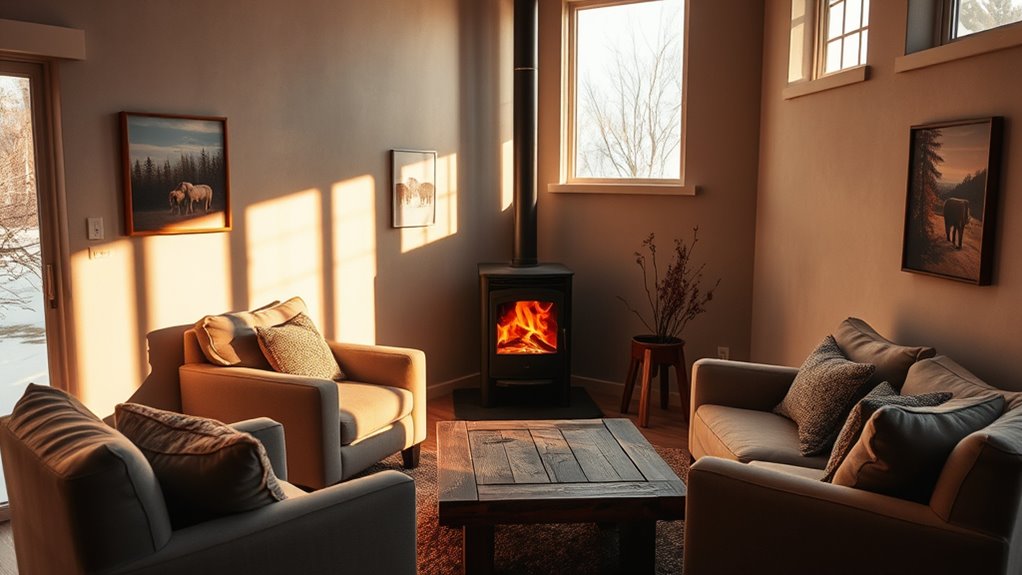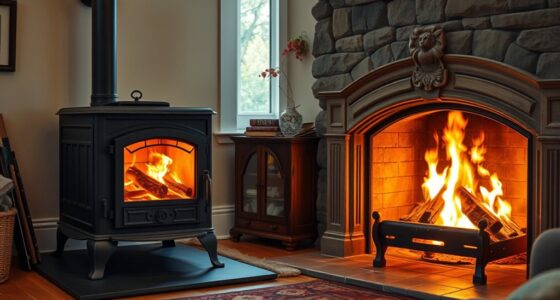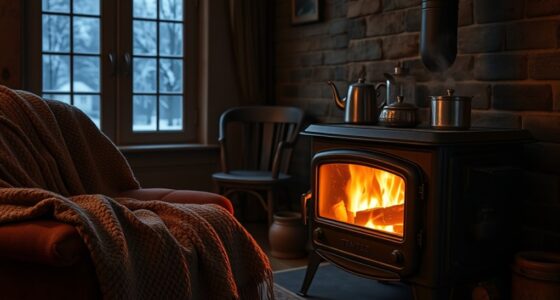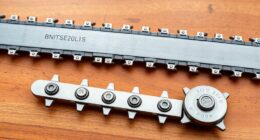Strategically using pellet stoves for zone heating helps you focus warmth where it’s needed most, saving energy and reducing costs. By placing stoves in central yet accessible locations and sealing drafts, you improve efficiency and safety. Proper installation, maintenance, and managing each stove ensure peak performance. With thoughtful planning, you can enjoy targeted comfort and significant savings. Keep exploring how to maximize your zone heating system and make the most of your pellet stoves.
Key Takeaways
- Install pellet stoves in central locations to maximize heat distribution and safety across designated zones.
- Use zone controls and thermostats for precise temperature management tailored to each area’s needs.
- Properly vent each stove and ensure clearances to prevent backdrafts and maintain efficient operation.
- Seal drafts and improve insulation to enhance zone heating efficiency and reduce heat loss.
- Regularly maintain and clean stoves to ensure optimal performance and safety in a multi-zone setup.
Benefits of Zone Heating With Pellet Stoves
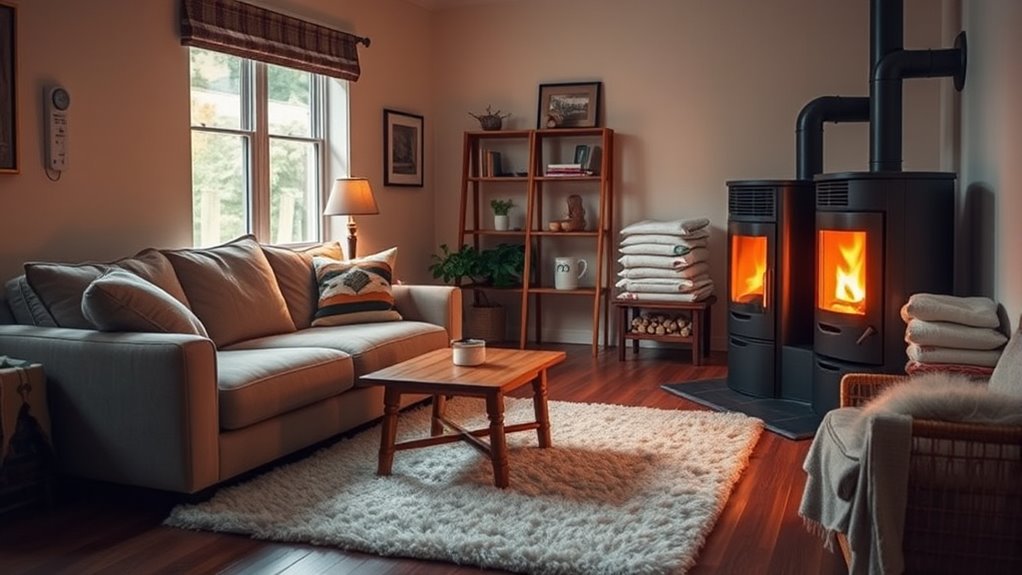
Zone heating with pellet stoves offers several advantages that can improve your home’s comfort and efficiency. One major benefit is enhanced fire safety, as pellet stoves are designed with safety features like automatic shut-off and secure fuel handling, reducing the risk of accidents. Additionally, pellet stoves are highly fuel-efficient because they burn pellets cleanly and consistently, providing more heat with less fuel. This efficiency helps you save money on energy bills and reduces waste. By focusing heat in specific zones, you avoid overheating unused spaces, further optimizing energy use. Incorporating toilet cleaner effectiveness into maintenance routines can also prevent debris buildup that may hinder stove operation. Regular cleaning and proper maintenance support pellet stove longevity, ensuring consistent performance over time. Proper ventilation is essential to ensure safe operation and adequate indoor air quality, which contributes to healthier living spaces. The combination of safety and fuel efficiency makes zone heating with pellet stoves an effective, reliable way to keep your home warm while maintaining control over your heating costs and safety.
Choosing the Right Locations for Stoves
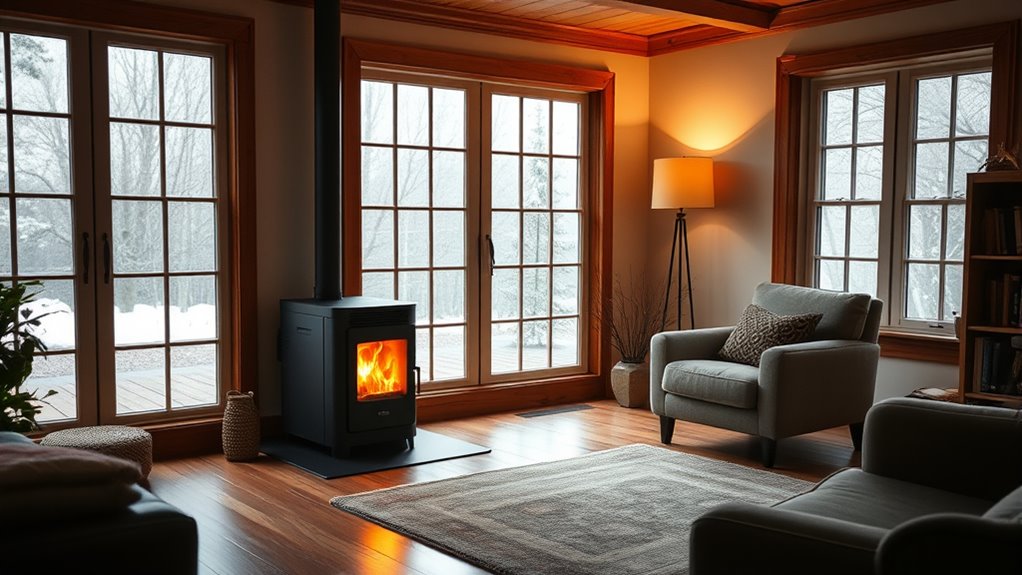
When choosing where to place your pellet stove, focus on ideal room placement to maximize heat distribution. Avoid installing it in drafty areas, as they can reduce efficiency and cause uneven heating. Carefully selecting the right spot ensures your stove heats effectively and keeps your home comfortable. Additionally, considering outdoor access can improve ventilation and safety. Proper placement also involves assessing the ventilation systems to prevent any buildup of harmful gases and ensure safe operation. Ensuring proper clearances and installation is also vital to maintain safety standards and prevent fire hazards, especially since correct air circulation can enhance overall efficiency and safety. Properly managing energy flow within your home can further optimize heat distribution and reduce energy waste.
Optimal Room Placement
Choosing the right location for your pellet stove is essential to maximize heating efficiency and safety. You should place the stove in a central spot to evenly distribute heat across your targeted zone. Consider the chimney design to ensure proper venting and avoid issues like backdrafts or smoke leaks. It’s also important to think about fuel storage; placing your fuel near the stove makes refilling easier and keeps it safe from moisture or pests. Avoid placing the stove near windows or high-traffic areas where drafts could affect performance. A well-placed stove not only improves heat distribution but also minimizes safety risks. Additionally, selecting a location with adequate ventilation is crucial to ensure proper airflow and prevent buildup of harmful gases. Proper ventilation is especially important with the recent AI discoveries that include manipulating quantum particles, which could influence environmental safety considerations. Taking time to select an ideal room ensures your pellet stove operates efficiently and keeps your space warm and secure. Proper placement can also help in reducing energy costs by optimizing heat flow and minimizing heat loss. Ensuring consistent air circulation around the stove can further enhance its efficiency and safety. Moreover, understanding local building codes is vital to ensure your installation complies with safety standards and regulations.
Avoid Drafty Areas
Placing your pellet stove in a draft-free area helps maintain consistent heat and improves efficiency. Drafts can cause uneven heating and make your stove work harder, increasing fuel consumption. Choose a location away from windows, doors, or vents where air can flow freely. This not only enhances comfort but also preserves the fireplace aesthetics by preventing cold spots or airflow disruptions. When selecting a spot, consider how pellet stove accessories like venting options or heat shields can further minimize drafts. Avoid areas prone to sudden temperature changes or drafts from fans, open windows, or poorly sealed gaps. A stable, draft-free spot ensures your stove performs at its best, providing even warmth and maintaining the visual appeal of your fireplace setup. Additionally, ensuring proper ventilation can prevent the buildup of harmful gases and improve overall air quality around your stove.
Assessing Your Home’s Heating Needs
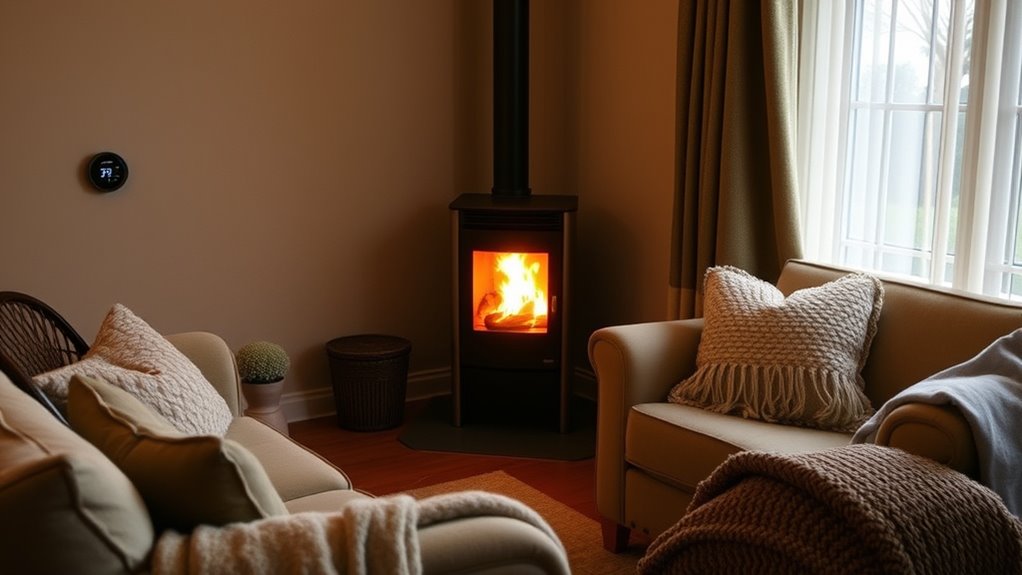
Before selecting a pellet stove, it’s essential to accurately assess your home’s heating needs. Start by evaluating which rooms require the most warmth and consider how often you use these spaces. Think about the fireplace ambiance you want, as a well-placed stove can enhance comfort and aesthetic appeal. Keep in mind that proper pellet stove maintenance guarantees consistent performance and energy efficiency. Measure the size of the areas you plan to heat to determine the stove’s capacity. Also, identify any drafts or insulation issues that might affect heating efficiency. Additionally, understanding suction power and filtration systems can help ensure your stove operates efficiently and maintains indoor air quality. Properly matching your stove’s performance capabilities to your home’s layout is crucial for optimal zone heating. By understanding your home’s specific requirements, you can choose the right pellet stove to provide effective, strategic zone heating without unnecessary energy costs.
Creating a Heating Zone Plan
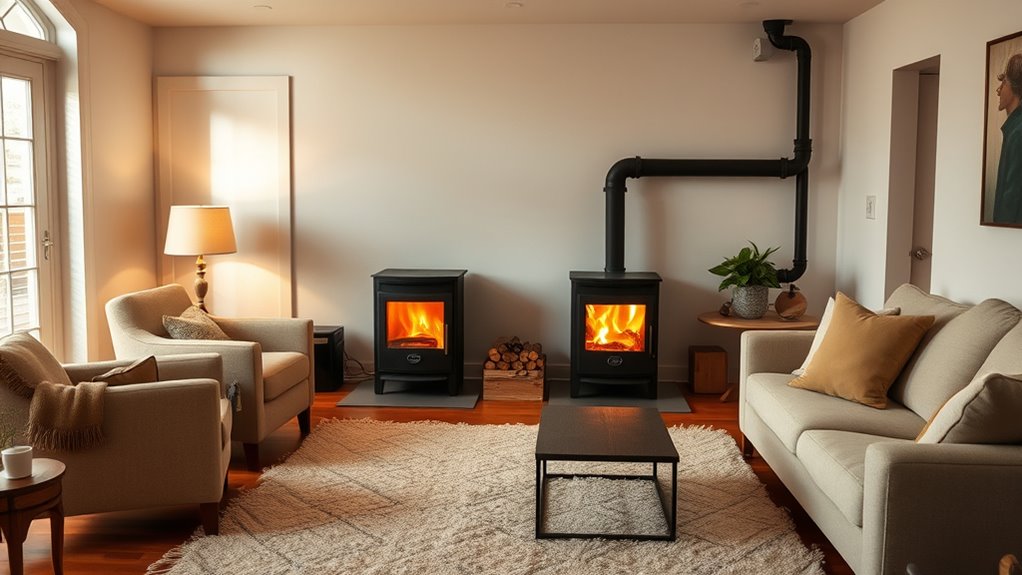
Creating a heating zone plan involves identifying which areas of your home need targeted warmth and designing a layout that efficiently directs heat where it’s most needed. To maximize furnace efficiency, focus on zones that require consistent heat and can benefit from pellet stove supplementation. Proper thermostat placement is vital; install thermostats in central locations within each zone to ensure accurate temperature readings. This helps prevent unnecessary heating and conserves energy. Consider the size and layout of each space to determine the best zones, grouping rooms with similar heating needs. Additionally, understanding the optimal conditions for seed production can inform insulation and environmental controls in your home, ensuring consistent temperature management. Incorporating attention in your zone planning process can enhance the effectiveness of your heating strategy. Regularly reviewing your zone plan aligns with SQA best practices by identifying areas for improvement and ensuring the system operates efficiently. Evaluating energy consumption patterns can help you fine-tune your zones for maximum efficiency. By planning carefully, you can reduce energy waste, improve comfort, and make your pellet stove use more effective. A well-designed zone plan ensures each part of your home gets the right amount of heat with minimal effort, and considering energy-efficient heating methods can further optimize your system.
Proper Placement and Installation Tips
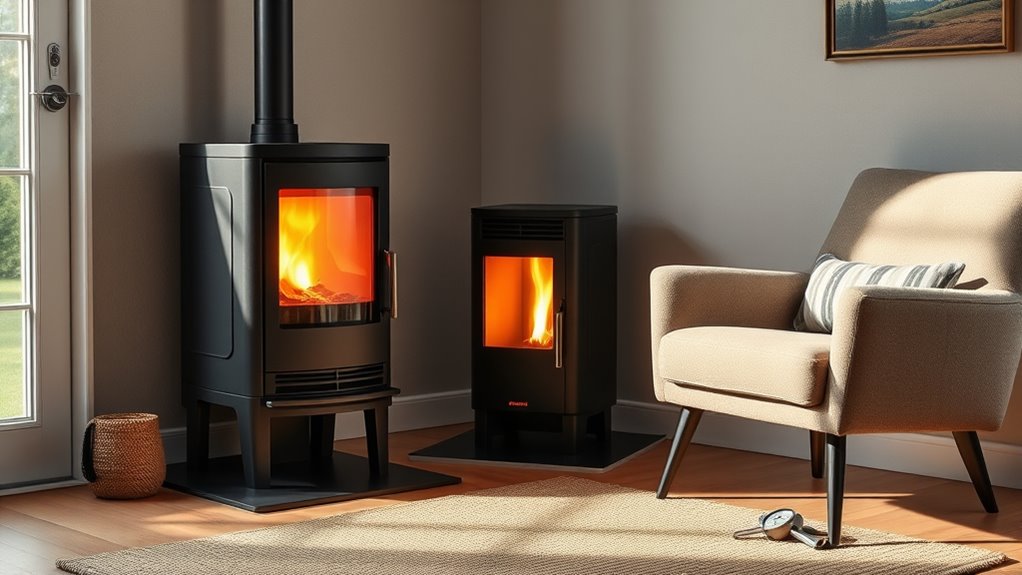
To get the best performance from your pellet stove, you need to focus on placing it in an ideal spot. Make sure the location allows for proper airflow and safety clearance, preventing any hazards. Also, follow secure installation practices to ensure your stove stays stable and functions efficiently.
Optimal Stove Placement
Choosing the right spot for your pellet stove is essential for safety and efficiency. Proper placement enhances pellet stove aesthetics and ensures ideal heat distribution. Position your stove in a central location within the zone to maximize warmth and reduce drafts. Keep it away from combustible materials and ensure proper clearance for safe operation. Additionally, consider easy access for regular maintenance schedules.
To maximize placement:
- Select a sturdy, level surface that supports the stove’s weight.
- Avoid areas prone to drafts or excessive humidity.
- Position near existing venting options for easier installation.
This careful placement not only improves efficiency but also makes future maintenance more manageable, keeping your stove running smoothly and safely.
Secure Installation Practices
Ensuring your pellet stove is properly installed is essential for safe and efficient operation. Start by choosing a location that complements your pellet stove aesthetics while providing easy access for maintenance. Make certain the stove is placed on a stable, non-combustible surface and away from high-traffic areas. Proper chimney compatibility is critical; select a chimney that meets safety standards and is compatible with your stove model. Securely connect the chimney to prevent leaks and ensure proper venting. Follow manufacturer instructions carefully to avoid fire hazards or carbon monoxide risks. Additionally, maintain clearances from walls and furniture to promote safe operation. Proper installation not only enhances safety but also maximizes the stove’s efficiency and visual appeal in your home.
Controlling and Managing Multiple Stoves
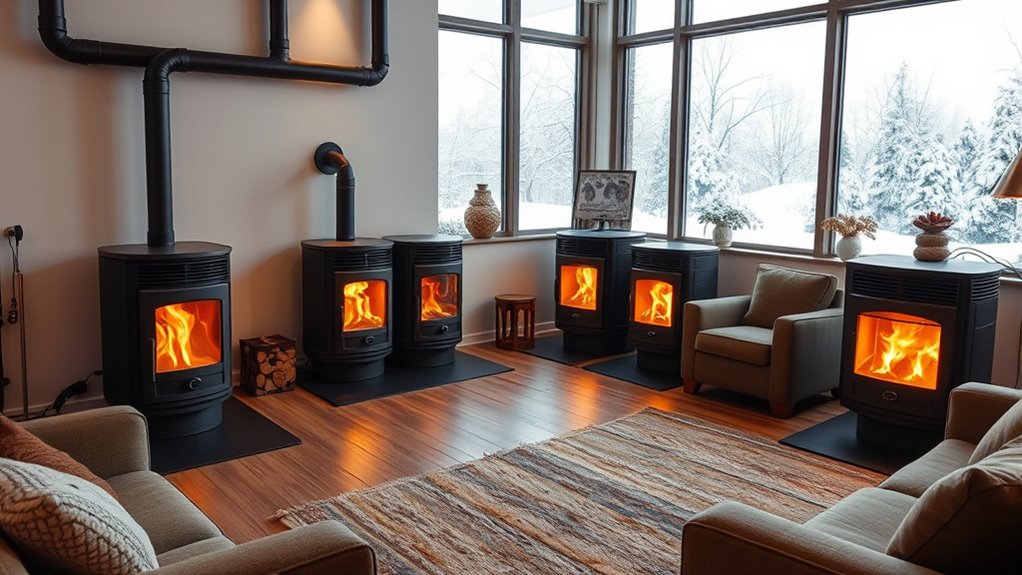
Managing multiple pellet stoves effectively requires careful coordination to maintain consistent heat and efficiency throughout your space. To do this, you should consider the following:
- Ensure proper chimney venting for each stove to prevent backdrafts and optimize airflow.
- Use compatible pellet stove accessories, such as thermostats and zone controls, to automate temperature regulation.
- Regularly monitor and adjust settings to balance heat distribution without overloading your system.
Smart management involves understanding how each stove interacts with your home’s layout. Efficient control minimizes fuel waste and reduces potential safety issues. By integrating accessories and maintaining proper venting, you keep your system running smoothly, ensuring each zone heats evenly and safely. Proper management ultimately enhances comfort and system longevity.
Insulation and Draft Prevention Strategies
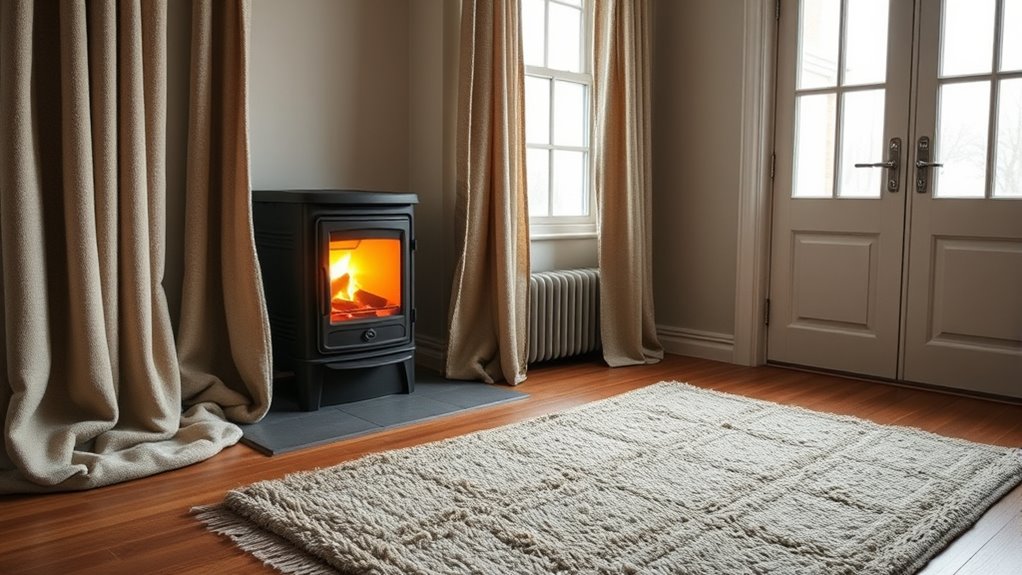
To keep your pellet stove heating efficient, start by sealing gaps around windows and doors to prevent drafts. Improving your wall insulation also helps retain heat and reduces energy loss. These simple steps can make a big difference in maintaining a warm, cozy zone.
Seal Gaps Effectively
Sealing gaps around doors, windows, and other openings is essential for maximizing the efficiency of your pellet stove. Proper sealing prevents warm air from escaping and cold drafts from entering, helping your heating zone stay consistent. Start by weatherstripping doors, which offers a simple, cost-effective way to reduce drafts. Check for leaks around windows and use caulk or foam sealant to close small gaps. For larger openings, consider installing door sweeps or draft stoppers. To enhance sealing:
- Use weatherstripping doors and windows regularly
- Seal cracks around window frames with caulk
- Add draft stoppers to gaps at the bottom of doors
Focusing on sealing gaps ensures your pellet stove heats efficiently, reducing energy waste and keeping your space more comfortable.
Enhance Wall Insulation
Enhancing your wall insulation is a key step in preventing drafts and maintaining consistent heat from your pellet stove. Proper insulation not only keeps the warmth inside but also improves your fireplace aesthetics by reducing drafts that can cause uneven heat distribution. Upgrading wall insulation minimizes heat loss, making your pellet stove more efficient and reducing energy costs. As you improve your insulation, consider using effective pellet stove accessories like draft stoppers or insulating panels that complement the aesthetic of your space. Well-insulated walls prevent cold spots and help your stove perform ideal , ensuring a cozy, inviting environment. With better insulation, you’ll enjoy a more comfortable home and a more attractive fireplace setup that blends seamlessly with your interior decor.
Cost Savings and Energy Efficiency
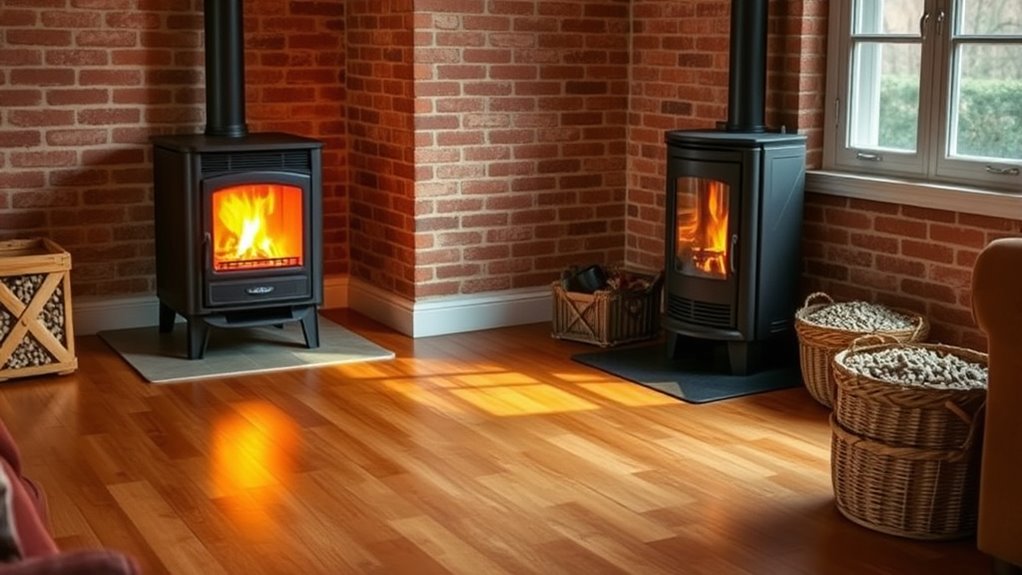
Pellet stoves can considerably reduce your heating costs by providing a highly efficient way to warm your home. Their impressive energy efficiency means you use less fuel while generating more heat, saving you money over time. Plus, the pellet stove aesthetics allow you to enjoy a cozy ambiance without sacrificing style. When choosing stove fuel options, you’ll find a variety of pellets made from recycled materials, which can be both economical and environmentally friendly. To maximize cost savings, focus on proper zone heating, targeting high-traffic areas. Additionally, consider the following benefits:
- High thermal efficiency minimizes wasted energy
- Consistent heat output reduces reliance on other heating systems
- Modern designs blend seamlessly with home decor, enhancing aesthetics
Safety Considerations for Zone Heating

While zone heating with pellet stoves offers energy savings and comfort, safety should always be a top priority. Guarantee proper ventilation requirements is essential to prevent the buildup of harmful gases like carbon monoxide. Always install your pellet stove in well-ventilated areas and follow manufacturer guidelines for airflow. Keep combustible materials, such as furniture, curtains, and paper, at a safe distance from the stove to reduce fire risks. Regularly check and maintain clearances around the unit, and never block ventilation vents. Use a carbon monoxide detector nearby to alert you to potential dangers. Proper safety measures not only protect your home but also ensure that your zone heating system remains efficient and reliable for years to come.
Maintenance and Upkeep for Optimal Performance
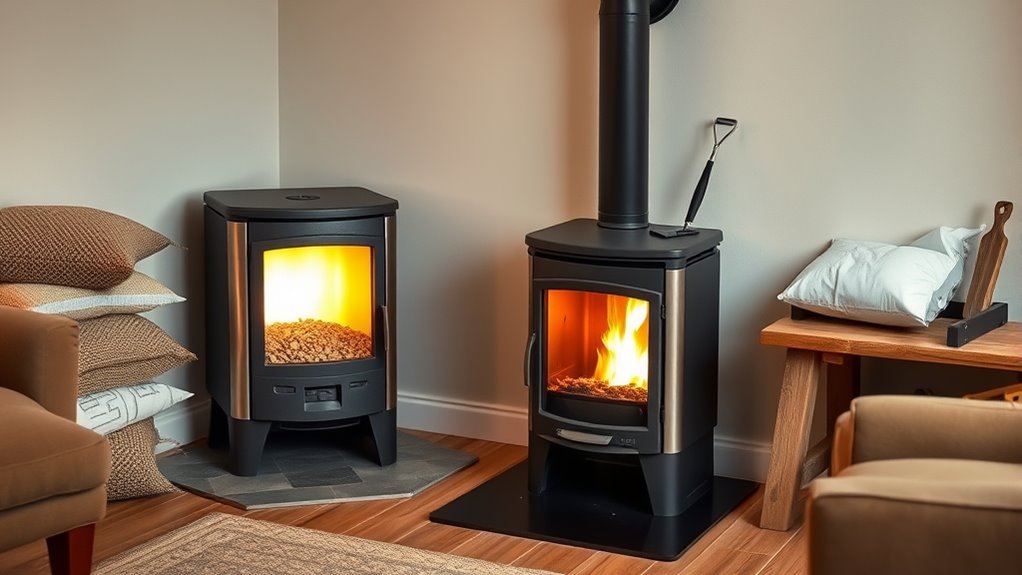
Regular maintenance is key to ensuring your pellet stove operates efficiently and safely. To keep your stove running smoothly, routinely clean the burn pot, ash pan, and venting system. Proper upkeep helps maintain *ideal* fuel combustion and consistent climate control. Additionally, check the auger and sensors for any blockages or wear that could affect performance. Use high-quality pellet stove fuel to prevent clogs and reduce buildup. Schedule professional inspections annually to fine-tune your stove’s components.
Regular cleaning and annual checks keep your pellet stove running safely and efficiently.
- Clean the interior and exterior surfaces regularly
- Inspect and replace worn parts as needed
- Keep the stove and surrounding area free of dust and debris
Frequently Asked Questions
How Does Zone Heating With Pellet Stoves Impact Indoor Air Quality?
Indoor air quality can be affected by how you heat your home. When using pellet stoves for zone heating, you might notice improved air filtration if the stove has a good filter, reducing dust and allergens. However, it’s important to monitor indoor humidity levels, as pellet stoves can dry out the air, leading to discomfort or respiratory issues. Proper maintenance guarantees cleaner air and a healthier environment.
Can Pellet Stoves Be Integrated With Existing Home Heating Systems?
Imagine adding a cozy touch to your home by integrating pellet stoves with your current heating system. You can do this smoothly by ensuring proper chimney maintenance and thoughtful stove placement. It’s a smart way to boost comfort and efficiency without overhauling your setup. Just make sure to consult professionals for seamless integration, and you’ll enjoy flexible, eco-friendly warmth that complements your existing system perfectly.
What Are the Environmental Benefits of Using Pellet Stoves for Zone Heating?
Using pellet stoves for zone heating offers notable environmental benefits. They burn renewable fuel made from compressed wood or biomass, reducing reliance on fossil fuels. This process lowers your carbon footprint because pellet stoves emit fewer greenhouse gases compared to traditional heating systems. By choosing pellet stoves, you support sustainable energy, reduce pollution, and contribute to a healthier environment, all while maintaining efficient, localized heating in your home.
How Do Pellet Stove Emissions Compare to Traditional Heating Systems?
Think of pellet stoves as cleaner runners in a race. Their emission levels are generally lower than traditional systems because they burn fuel more efficiently. You benefit from higher combustion efficiency, which reduces pollutants and particulates. This means fewer emissions released into the air, making pellet stoves a greener choice. Overall, they produce markedly cleaner emissions, helping you breathe easier and contribute to a healthier environment.
Are There Specific Permits or Regulations for Installing Multiple Pellet Stoves?
You’ll need to check permit requirements and local regulations before installing multiple pellet stoves. Many areas require permits to guarantee safety standards and proper installation. Local regulations may also restrict the number of stoves or specify venting and clearance rules. It’s best to contact your local building department or code enforcement office to get accurate information, ensure compliance, and avoid potential fines or safety issues.
Conclusion
By strategically zoning your home with pellet stoves, you transform chilly corners into cozy retreats, like warming your hands by a crackling fire. Think of each stove as a guiding flame, perfectly placed to illuminate your comfort. With proper planning, insulation, and maintenance, you’ll enjoy not just warmth, but a home that feels inviting and efficient. Embrace this approach, and let your living space glow with tailored, sustainable heat.
